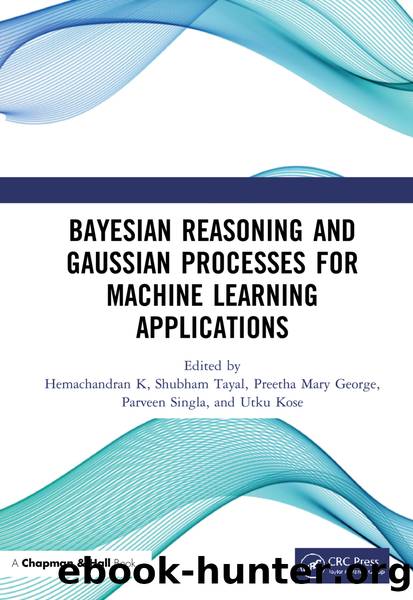Bayesian Reasoning and Gaussian Processes for Machine Learning Applications by K Hemachandran;Tayal Shubham;George Preetha Mary;Singla Parveen;Kose Utku;

Author:K, Hemachandran;Tayal, Shubham;George, Preetha Mary;Singla, Parveen;Kose, Utku;
Language: eng
Format: epub
Publisher: CRC Press LLC
Published: 2022-03-03T00:00:00+00:00
6.3.3 How Does It Work?
Gas leakage is one of the burgeoning topics right now across the globe. It has affected the economy and human resource to a great extent. A significant incident was the Vizag gas leakage where 11 people lost their lives and more than 1,000 people got sick after being exposed to the gas. Minor gas leaks happen every day across the globe that represent both direct and indirect risk within the health, environment, and safety aspects. Even smaller gas leaks are undesirable as they represent the risk of escalation that often leads to shut down or reduced production.
As a result, we developed a dependable system that uses machine learning and sensor data to identify leaks without the need for human intervention. Our suggested system has been tested on a hydrocarbon gas such as methane under temperature and pressure conditions. The dataset used contains the parameter of varying temperature and pressure of the underground pipeline in the city of Boston (dataset of 3 years). The flow of the system is shown in Figure 6.6.
FIGURE 6.6 Flow chart of proposed model.
The linear regression in the Scikit-learn package was used to evaluate the study hypothesis and the machine learning model. The systemâs key components include sensor data (methane gas), a machine learning model, and false alarm reduction. We carried out our research based on the paper titled âMachine learning and acoustic method applied to leak detection and location in low-pressure gas pipelinesâ proposed by Rodolfo Pinheiro da Cruz, which uses acoustic method to detect the leaks in the gas pipelines. Our finding contradicts earlier studies in that it is not dependable for long-distance pipelines, and the effectiveness of acoustic sensors decreases as pipeline distance increases. We proposed a work based on machine learning, in which we used a linear regression using the Scikit-learn library to figure out the leakage and identify the location of the leakage in the system to be able to warn construction site staff or the company about the leakage and take immediate action to avoid gas leakage and eliminate its causes. Primary gas detection will generate an alarm when sensing a given amount of gas in order to notify that the area might be explosive. However, it is necessary that small leaks are detected as well. Regression analysis is a form of predictive modeling that is useful to predict the output (i.e., dependent variable) of the system from the given input (i.e., independent variable) of the system. We chose regression as our primary method because it deals with continuous data and the significant dependent variable is numerical, as we use the sensor data where the value generated by the sensors are numeric. This helps us evaluate the output in real time. Since linear regression operates on continuous variables, it can evaluate the value in real time, and it is more effective than logical regression in gas detection (Figure 6.7).
FIGURE 6.7 A sample dataset of temperature and pressure of the gas.
The dataset above contains the temperature and pressure of the gas (methane, CH4) at a specific moment, as shown by the columns FIRST_D and LAST_D.
Download
This site does not store any files on its server. We only index and link to content provided by other sites. Please contact the content providers to delete copyright contents if any and email us, we'll remove relevant links or contents immediately.
| AI & Machine Learning | Bioinformatics |
| Computer Simulation | Cybernetics |
| Human-Computer Interaction | Information Theory |
| Robotics | Systems Analysis & Design |
Algorithms of the Intelligent Web by Haralambos Marmanis;Dmitry Babenko(9832)
Test-Driven Development with Java by Alan Mellor(7657)
Data Augmentation with Python by Duc Haba(7541)
Principles of Data Fabric by Sonia Mezzetta(7317)
Learn Blender Simulations the Right Way by Stephen Pearson(7233)
Microservices with Spring Boot 3 and Spring Cloud by Magnus Larsson(7068)
RPA Solution Architect's Handbook by Sachin Sahgal(6459)
Jquery UI in Action : Master the concepts Of Jquery UI: A Step By Step Approach by ANMOL GOYAL(6447)
The Infinite Retina by Robert Scoble Irena Cronin(6170)
Hadoop in Practice by Alex Holmes(6138)
Big Data Analysis with Python by Ivan Marin(5884)
Life 3.0: Being Human in the Age of Artificial Intelligence by Tegmark Max(5474)
Pretrain Vision and Large Language Models in Python by Emily Webber(4841)
Infrastructure as Code for Beginners by Russ McKendrick(4623)
WordPress Plugin Development Cookbook by Yannick Lefebvre(4342)
Functional Programming in JavaScript by Mantyla Dan(4216)
The Age of Surveillance Capitalism by Shoshana Zuboff(4209)
Embracing Microservices Design by Ovais Mehboob Ahmed Khan Nabil Siddiqui and Timothy Oleson(4114)
Applied Machine Learning for Healthcare and Life Sciences Using AWS by Ujjwal Ratan(4092)
